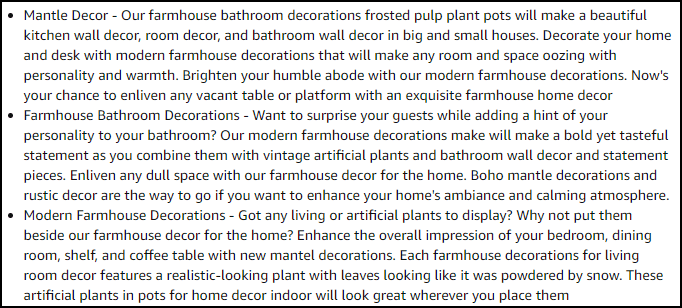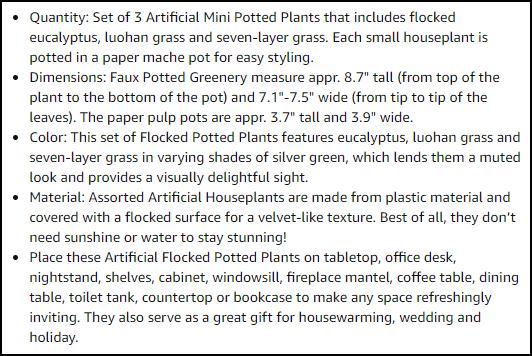Amazon Listing Optimization: 5 Effortless Ways to Write Persuasive Amazon Bullet Points

When optimizing an Amazon listing, the goal is to attract more prospects to the listing, and then once they’re on the page, position your product so well that buying it becomes a no-brainer.
Towards that goal, in this article, we’re going to focus on one area of your Amazon listing that can make a big difference: the bullet points.
Here’s the thing: We all know that many shoppers barely read the actual listing copy. However, a percentage of shoppers will read every word. For that reason, and to increase keyword density for discoverability…you need to make sure your bullet points are, well, on point!
We’ll cover what type of information you want to include in your bullets shortly. But if you’re going to look to Amazon for guidance on how to write your bullets…
You won’t get too far.
The only help Amazon’s Product Page Guidelines offers is several things you can’t include—most of them self-explanatory—and the following sentence:
“Bullet points must be clearly written and help customers understand the product.”
So, with that in mind…
Let’s cover 5 SPECIFIC ways you can write persuasive Amazon bullet points.
Amazon Bullet Point Tip # 1 – Resist The Wall
When you’re writing your Amazon bullet points, you want to avoid creating a wall of text.
The way you do that is simple: Resist the urge to use the maximum character limit that Amazon gives you for bullets.
Just like walls block your vision, the same goes for layers of text; the visitor’s eyes gloss over with screen fatigue.
Amazon allows you 500 characters for each bullet.
You might be tempted to use all the characters available. But on the customers’ side, you want to think about what that looks like.
Case in point:
Think about it: If a visitor never reads your bullets—because the amount of text is overwhelming—they don’t learn the key benefits your product has to offer, and if they don’t find out the information elsewhere, they aren’t purchasing.
Ultimately, testing the bullet length will give your clarity on whether longer or shorter bullets work for your particular listing.
But in general, we’ve seen shorter (more uniform) bullets tend to lead to better conversions.
Amazon Bullet Point Tip # 2 – So What?
One of the easiest traps to fall into when you’re writing your Amazon bullet points is to think that your potential customer understands what each feature means.
This is a big mistake.
Why?
Because one of the largest reasons why a customer doesn’t buy is their inability to see how your product will help them.
Telling them all the great features of your product, but not translating those features into benefits requires them to use more energy—to decipher what a feature means—than they signed up for.
Customers buy products to solve problems and reduce effort.
You want to make the decision to purchase your product effortless for the visitors to your Amazon product listing.
How?
Take responsibility for their imagination.
Take an iPhone wallet case, for example:
You might think that the utility of an iPhone wallet case is self-explanatory.
And it is.
But for the prospect, you want to take responsibility from their hands, and paint a picture of how they’d use it.
Here’s an example:
Store Everything in One – Time & Space Saver: Juggling two items at once can be a hassle. If you’re in a rush, you might drop and break your phone, or you might set your wallet down, and forget about it.That’s where securing your phone and wallet in a single case comes in handy.
Make sense?
When you’re writing your bullets, a useful phrase to keep in mind is “so what”?
Write out all the features of your product, and then create at least 5 benefits for each feature. Then study customer reviews and see which benefits show up most frequently.
Place the most frequently mentioned benefits in your bullets.
But keep in mind, you want to start each bullet with the benefit in the “headline.” Then explain how the feature translates into a benefit throughout the rest of the bullet.
Amazon Bullet Point Tip #3 – Throw Pebbles
Ever heard the saying, “Throw stones at your competitors?”
Well, you definitely don’t want to throw stones at your competitors, but you can do something else: throw pebbles.
Here’s what I mean:
You want to create some notable distinctions between you and your competitors without calling them out by name.
In fact, Amazon’s Seller Code of Conduct suggests you don’t want to call out competitors directly.
And besides, I’m not sure you’d want to do that anyway. With a touch of softness, you can get far.
Let’s look at a few examples:
Notice how the first line reminds the reader of the frustration they face when dealing with alternative products—in this case, live plants.
That’s a nice example of throwing pebbles.
Now, check this one out:
Right in the first sentence, this seller mentions that competing products don’t have the same carrying capacity.
Then the seller goes on to paint a picture of what could be stored in the product due to its large capacity.
See, you don’t have to call out the competitors aggressively. Simply toss a few pebbles their way.
Amazon Bullet Point Tip #4 – Give the Jewels
When you’re building out your Amazon listing, you want to emphasize your product and the problem it solves, but you also want to help your prospect understand their problem better—regardless of whether they buy from you or not.
How do you do that?
Give them insights.
Tell them what features to look for when buying the product you’re selling. Tell them why it matters. Tell them what makes the biggest difference in having success with the product after they buy it.
And don’t be afraid to reveal the holes that your product can’t fill on their journey.
For example, if you’re selling a backpack, you might point out that the backpack is great for everyday travel, but due to its fabric and zipper construction, it’s not designed for wet weather conditions.
This sort of candidness can indirectly get attributed to your product’s quality.
Think about it…
If someone is willing to hold your hand through the purchasing process…
Even if their offer isn’t the most all-encompassing…
You might be more likely to stick with them, because the clarity they provided you inadvertently makes you think that they created a product that they put a lot of thought into as well.
Amazon Bullet Point Tip #5 – Laser In
When you’re writing your Amazon bullet points, handle them like a real-life bullet. You want to write them so that they each pierce one big idea.
So that’s why I say laser in.
And the idea behind this is simple:
Clarity.
Focusing on one big idea per bullet is a forcing function for you as a seller because it forces you to dive deep into your market to find out what 5 selling points matter most to your prospect.
But not only that…
Focusing on one big idea helps your prospect gain a concrete understanding of what your product will look like in their life.
Here are some bullet themes you might consider:
- Quality/Construction
- Situational Use
- Longevity
- Target Audience
- Convenience
Take Quality/Construction for example…
Prospects want to know that what you have to offer is the real deal.
Depending on your product, tell them how the materials, process of manufacturing, or the origin of your product helps the product do its job.
This is one area where throwing pebbles at your competitors comes in handy. You can easily point out that competitors sometimes use counterfeit material. Or you can highlight how the process that competitors use to manufacture their products compromises the effectiveness of the product or its end result.
Whatever bullet themes you use, make sure each bullet only focuses on one.
Here’s a listing that executed this idea well. Of course, they could have used more persuasive bullet headlines, but nonetheless, they’re a good example of practicing monogamous bullets:
When we’re talking about persuasion, single-focus bullet points breed clarity. And clarity tends to be more persuasive.
Wrapping Up
With some research and precision, you can write Amazon bullet points that grab a visitor’s interest and turn them into a buyer.
The more buyers you have, the better your page ranking, and the more sales will come flooding your way.
Set aside some time this week to put these 5 Amazon bullet point tips to the test.
Happy Selling,
The Page.One Team
The Last Word:
For years, sellers capitalized the beginning section (i.e., the headline) of each bullet. Heck, we did it too. But recently there’s been “chirp” that amazon is suppressing listings that have fully capitalized bullet headlines.
Here is what Amazon’s guidelines say:
“Use Capital Letters only for the beginning of each word. Do not use all Capital Letters throughout the attribute. This applies for Product Title, Bullet Points and/or Product Description”









